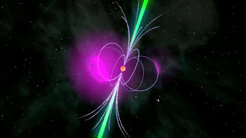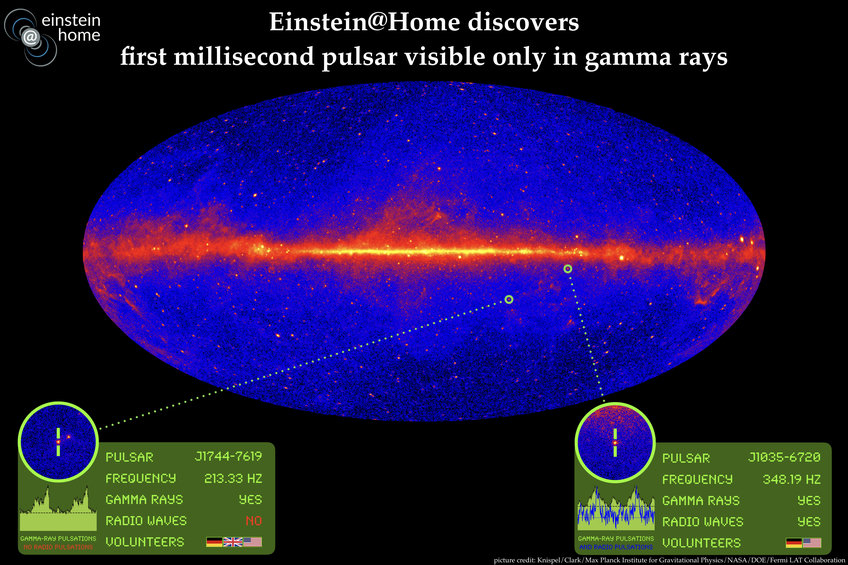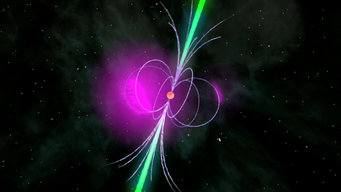Einstein@Home discovers first millisecond pulsar visible only in gamma rays
Distributed volunteer computing project finds two rapidly rotating neutron stars in data from Fermi gamma-ray space telescope
The distributed computing project Einstein@Home aggregates the computing power donated by tens of thousands of volunteers from across the globe. In a survey of the gamma-ray sky, this computer network has now discovered two previously unknown rapidly rotating neutron stars in data from the Fermi gamma-ray space telescope. While all other such millisecond pulsars have also been observed with radio telescopes, one of the two discoveries is the first millisecond pulsar detectable solely through its pulsed gamma-ray emission. The findings raise hopes of detecting other new millisecond pulsars, e.g., from a predicted large population of such objects towards the center of our Galaxy. Scientists from the Max Planck Institute for Gravitational Physics in Hannover and the Max Planck Institute for Radio Astronomy in Bonn closely collaborated to enable the discoveries.

“We made these two new discoveries in our large-scale Einstein@Home gamma-ray pulsar survey. This feat was only possible by using novel and more efficient search methods, improved Fermi Large Area Telescope (LAT) data, and the huge computing power provided by Einstein@Home,” says Dr. Colin Clark from Jodrell Bank Centre for Astrophysics, lead author of the paper published in Science Advances, who was a doctoral student at the Max Planck Institute for Gravitational Physics when he made the discoveries. “After we found the two millisecond pulsars with Einstein@Home we pointed a large radio telescope at them and expected to find their pulsed radio emission. That was the case for every other millisecond pulsar known until then. To our surprise one of our discoveries remained entirely radio-quiet.”
This shows that these “blind” gamma-ray pulsar searches have the potential to discover a hitherto unknown population of radio-quiet millisecond pulsars. These might be behind other unidentified Fermi-LAT sources, or the gamma-ray glow seen towards the center of our Galaxy.
Born in supernova explosions
Neutron stars are compact remnants from supernova explosions and consist of exotic, extremely dense matter. They measure about 20 kilometers across and weigh more than our Sun. Because of their strong magnetic fields and fast rotation they emit beamed radio waves and energetic gamma rays similar to a cosmic lighthouse. If these beams point towards Earth during the neutron star's rotation, it becomes visible as a pulsating radio or gamma-ray source – a so-called pulsar.
Millisecond pulsars form when a pulsar is spun up by accreting matter from a companion star. The inflow of material from the partner star can accelerate the pulsar up to hundreds of rotations in a single second. Once the accretion ends, the rapidly rotating neutron star can be observed as a millisecond pulsar.
Two new millisecond pulsars
The new publication describes the discovery of two previously unknown gamma-ray pulsars, which are called PSR J1035−6720 and PSR J1744−7619 after their respective sky positions. The first of the two city-sized neutron stars spins a dazzling 348 times each second, and the latter 213 times each second. After the initial discoveries, their astrophysical parameters were refined by a re-analysis of the Fermi-LAT data.
These improved parameters were used to search for the radio pulsations of the two sources in archival radio telescope data and in new observations with the Parkes Radio Telescope. While PSR J1035−6720 was discovered as an unusually faint radio millisecond pulsar, no radio waves at all were detected from PSR J1744−7619. This makes it the first radio-quiet millisecond pulsar ever discovered.
A hidden pulsar population

It is possible that the lighthouse-like radio beams of PSR J1744−7619 do not point towards Earth, while the gamma-ray beams do. The researchers addressed this question by comparing the observed gamma-ray emission with theoretical models. They showed that the models that describe the gamma-ray emission well, predict a detectable radio signal. Its absence means that PSR J1744−7619 must either be extremely radio-faint, or that the models must be incomplete.
According to some predictions, the observed excess of high-energy gamma-radiation from the central region of the Milky Way could be due to a hidden population of thousands of millisecond pulsars. While only a handful might be detectable with current large radio telescopes, gamma-ray searches might have a better chance of finding more of these sources.
Einstein@Home searches for gamma-ray pulsars hidden in binary systems
“With the help of our volunteers we searched through 152 unidentified pulsar-like sources from the Fermi-LAT Catalog,” says Prof. Dr. Bruce Allen, director of Einstein@Home and director at the Max Planck Institute for Gravitational Physics in Hanover. “We have shown that 19 of these do not only look like pulsars, they in fact are pulsars and in some cases quite unusual to boot. Personally, I would bet that many of the remaining 133 are also pulsars, but hidden in binary systems, where they are more difficult to find. At the moment Einstein@Home is chasing after those binary pulsars and I hope we will soon find some.”
“This is a marvelous example of modern-day astrophysics: we use expertise from gravitational wave astronomy to cleverly analyze gamma-ray data in order to reveal sources that complement our knowledge from radio observations. Brilliant,” concludes Michael Kramer, director at Max Planck Institute for Radio Astronomy, head of its “Fundamental Physics in Radio Astronomy” research department, and co-author of the paper.
Background information after the page break
Additional information: Who made the discoveries?
The discoveries were enabled by tens of thousands of Einstein@Home volunteers who have donated their CPU time to the project. Without them this survey could not have been performed and these discoveries could not have been made. The team is especially grateful to those volunteers whose computers discovered the 2 pulsars reported in the Science Advances publication (where the volunteer’s name is unknown or private, we give the Einstein@Home username in quotation marks):
- PSR J1035−6720: “WSyS”; Kurt Kovacs, of Seattle Washington, USA; and the ATLAS Cluster, AEI, Hannover, Germany.
- PSR J1744−7619: Darrell Hoberer, of Gainesville, TX, USA; the ATLAS Cluster, AEI, Hannover, Germany; Igor Yakushin of Chicago, IL, USA and the LIGO Laboratory, USA; and Keith Pickstone of Oldham, UK.
Additional information: Einstein@Home quick facts
Einstein@Home is a distributed volunteer computing and connects computers and smartphones from the general public from all over the world. The project volunteers donate spare computing time on their devices. Until now more than 460,000 volunteers have participated, making Einstein@Home one of the largest projects of this kind. The current aggregate computing power contributed by about 53,000 computers from 33,000 active volunteers is about 6.8 petaFLOPS. This would secure Einstein@Home a position among the top 15 on the TOP500 list of supercomputers.
Since 2005, Einstein@Home has analyzed data from the gravitational wave detectors within the LIGO Scientific and the Virgo Collaborations for gravitational waves from unknown, rapidly rotating neutron stars. As of March 2009, Einstein@Home has also been involved in the search for signals from radio pulsars in observational data from the Arecibo Observatory in Puerto Rico and the Parkes Observatory in Australia. Since the first discovery of a radio pulsar by Einstein@Home in August 2010, the global computer network has discovered 55 new radio pulsars. A search for gamma-ray pulsars in data of the Fermi satellite was added in August 2011. It has discovered 23 new gamma-ray pulsars as of today.
Scientific supporters are the Max Planck Institute for Gravitational Physics (Albert Einstein Institute, Hanover) and the Center for Gravitation and Cosmology at the University of Wisconsin-Milwaukee with financial support from the National Science Foundation and the Max Planck Society.
Additional information: Einstein@Home gamma-ray pulsar survey
Enlisting the help of tens of thousands of volunteers from all around world donating idle compute cycles on their tens of thousands of computers at home, the team was able to conduct a large-scale survey with the distributed computing project Einstein@Home. In total this search required about 10,000 years of CPU core time. It would have taken more than one thousand years on a single household computer. On Einstein@Home it finished within one year – even though it only used a fraction of the project’s resources.
The scientists selected their targets from 1000 unidentified sources in the Fermi-LAT Third Source Catalog by their gamma-ray energy distribution as the most “pulsar-like” objects. For each of the 152 selected sources, they used novel, highly efficient methods to analyze the detected gamma-ray photons for hidden periodicities.
Additional information: “Blindly” detecting gamma-ray pulsars
Finding the periodic pulsations from gamma-ray pulsars is very difficult – even more so from the very fast millisecond pulsars. On average only 10 photons per day are detected from a typical pulsar by the LAT onboard the Fermi spacecraft. To detect periodicities, years of data must be analyzed, during which the pulsar might rotate tens of billions of times. For each photon one must determine exactly when during a single milliseconds rotation period it was emitted. This requires searching over long data sets with very fine resolution in order not to miss any signals. The computing power required for these “blind searches” – when little to no information about the pulsar is known beforehand – is enormous.
The new methods used in the Einstein@Home survey improve the search sensitivity without increasing the associated computational costs. They consist of an initial search stage more sensitive than in any other Einstein@Home gamma-ray search before. The initial search produces a number of interesting candidates which are then followed up on with an even more sensitive second stage, which zooms in and narrows down the uncertainty in the pulsars physical properties. The final step of the search is not performed on Einstein@Home, but on the Atlas computer cluster at the Max Planck Institute for Gravitational Physics in Hannover.
Previous similar blind searches have detected 37 gamma-ray pulsars in Fermi-LAT data. All blind search discoveries in the past 5 years have been made by Einstein@Home which has found a total of 23 gamma-ray pulsars in blind searches, more than a third of all such objects discovered through blind searches.













